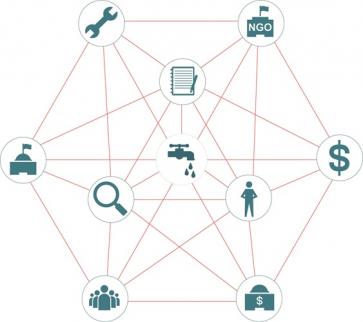Asking whether building hardware is better than a WASH systems approach is like asking whether building bicycle wheels is better than creating a transport network.
Published on: 16/06/2017
I like a good debate and I'm a self-confessed WASH systems nerd, so I was sorry to miss the recent one in Addis that pitted "systems approaches" against "infrastructure approaches" for WASH. That said, with the excellent blog on the debate by our friends at LINC as background, I'll weigh in after the fact!
Let me start my contribution by saying that I think the premise is fundamentally flawed. Not only that, but that the understanding of what constitutes a systems approach to WASH risks creating confusion and putting people off.
To understand my problem consider a debate along the lines of "what is more important: building bicycles or building bicycle wheels?"; or perhaps "what is more important: building bicycles or building roads"; or to reduce it to ultimate absurdity – "what is more important: making tyres or building roads?". You get the point.
Water supply and sanitation infrastructure are critical elements of the systems that deliver water and sanitation services. They are part and parcel of the WASH system. Seen this way, the failure to build decent quality infrastructure is as much a systems failure as is the failure to adequately operate or maintain it: a failure of procurement systems; or oversight systems; or accountability systems.
 Too much writing, including LINC's blog, suggests (explicitly or implicitly; intentionally or unintentionally) that systems approaches consist of little more than the analytical techniques for understanding systems: the causal diagrams; network analyses; Bayesian network; agent based models etc. But these are nothing more than one (important) part of the toolbox that supports adopting a systems perspective. Actually, I'd argue that the most important part of the systems approach is the initial understanding that, as the title says, the whole system is the system! And, that for the whole system to deliver the services that it is intended for, every part of it must work all the time (or, when it doesn't it must be able to fix itself).
Too much writing, including LINC's blog, suggests (explicitly or implicitly; intentionally or unintentionally) that systems approaches consist of little more than the analytical techniques for understanding systems: the causal diagrams; network analyses; Bayesian network; agent based models etc. But these are nothing more than one (important) part of the toolbox that supports adopting a systems perspective. Actually, I'd argue that the most important part of the systems approach is the initial understanding that, as the title says, the whole system is the system! And, that for the whole system to deliver the services that it is intended for, every part of it must work all the time (or, when it doesn't it must be able to fix itself).
Going back to bicycles. The bicycle isn't just a wheel – it's a saddle, a frame, brakes, wheels, tires; to be useful it needs a road to run on; and to be sustainable it needs someone to fix it when it breaks down. As such, the wheels, saddles, frames, brakes, roads, riders, repairers ..... can all be seen as parts of much larger a transport system.
Rural WASH service delivery over the last decades has, when viewed through the cycling metaphor, largely concerned itself with providing (often poor quality) wheels and assuming that "the community" will build the rest of the bike – and the roads too! Yet in my understanding a systems approach, when properly applied, implies that before we start handing out free wheels, we need to have a long hard look at the entire transport system, try to identify where (all) the weaknesses are, before starting to work systematically to fix them.
And yes, causal diagrams and network analyses are really useful tools to aid in that initial analysis. But so too – moving from bicycles back to WASH – are life-cycle cost analyses and asset inventories and surveys of institutional strength.
Adopting a systems strengthening approach in WASH implies nothing more (or less) than letting this diagnosis drive the prioritisation of interventions. And yes, in any situation where large numbers of people remain unserved, strengthening the systems around procuring and delivering new infrastructure will have a high priority. But probably no higher than ensuring that the systems for operating, maintaining and upgrading that infrastructure are also in place. So, to put it simply, infrastructure approaches are (or should be) part of systems approaches, because, when they're not, the result is failing or substandard services.
At IRC we have strong opinions and we value honest and frank discussion, so you won't be surprised to hear that not all the opinions on this site represent our official policy.